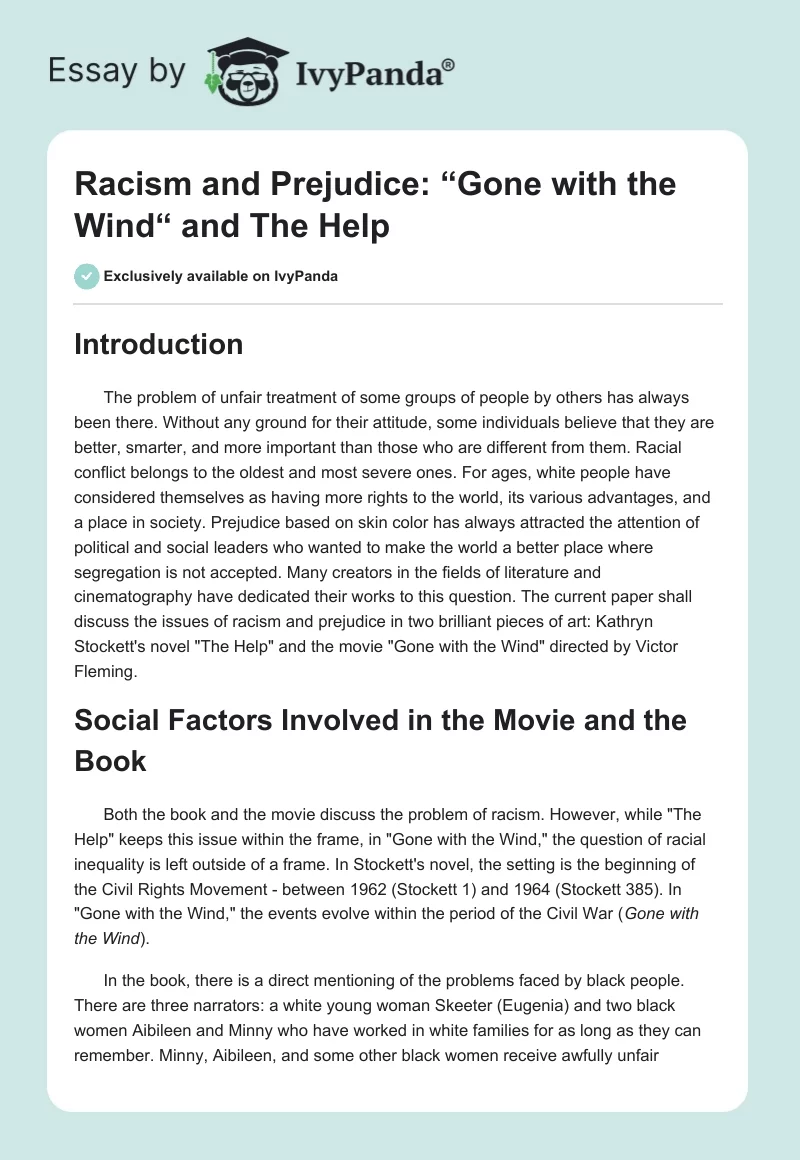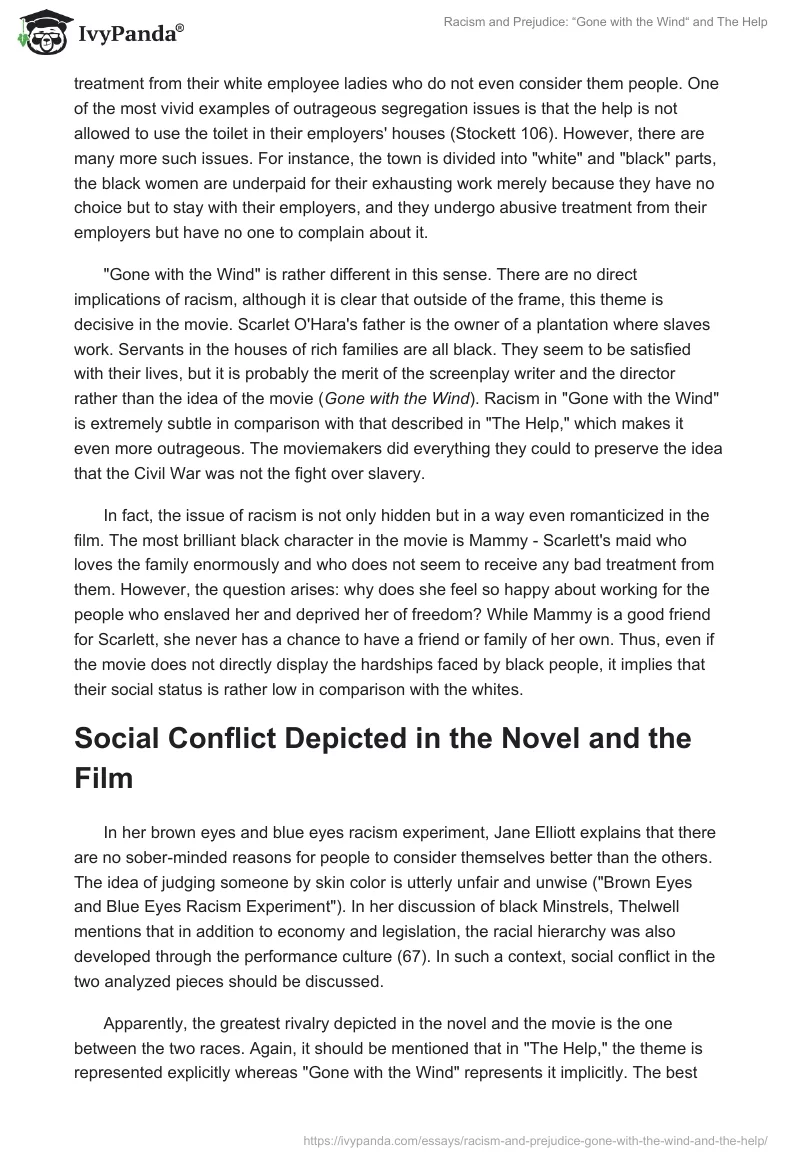Introduction
The problem of unfair treatment of some groups of people by others has always been there. Without any ground for their attitude, some individuals believe that they are better, smarter, and more important than those who are different from them. Racial conflict belongs to the oldest and most severe ones. For ages, white people have considered themselves as having more rights to the world, its various advantages, and a place in society. Prejudice based on skin color has always attracted the attention of political and social leaders who wanted to make the world a better place where segregation is not accepted. Many creators in the fields of literature and cinematography have dedicated their works to this question. The current paper shall discuss the issues of racism and prejudice in two brilliant pieces of art: Kathryn Stockett’s novel “The Help” and the movie “Gone with the Wind” directed by Victor Fleming.
Social Factors Involved in the Movie and the Book
Both the book and the movie discuss the problem of racism. However, while “The Help” keeps this issue within the frame, in “Gone with the Wind,” the question of racial inequality is left outside of a frame. In Stockett’s novel, the setting is the beginning of the Civil Rights Movement – between 1962 (Stockett 1) and 1964 (Stockett 385). In “Gone with the Wind,” the events evolve within the period of the Civil War (Gone with the Wind).
In the book, there is a direct mentioning of the problems faced by black people. There are three narrators: a white young woman Skeeter (Eugenia) and two black women Aibileen and Minny who have worked in white families for as long as they can remember. Minny, Aibileen, and some other black women receive awfully unfair treatment from their white employee ladies who do not even consider them people. One of the most vivid examples of outrageous segregation issues is that the help is not allowed to use the toilet in their employers’ houses (Stockett 106). However, there are many more such issues. For instance, the town is divided into “white” and “black” parts, the black women are underpaid for their exhausting work merely because they have no choice but to stay with their employers, and they undergo abusive treatment from their employers but have no one to complain about it.
“Gone with the Wind” is rather different in this sense. There are no direct implications of racism, although it is clear that outside of the frame, this theme is decisive in the movie. Scarlet O’Hara’s father is the owner of a plantation where slaves work. Servants in the houses of rich families are all black. They seem to be satisfied with their lives, but it is probably the merit of the screenplay writer and the director rather than the idea of the movie (Gone with the Wind). Racism in “Gone with the Wind” is extremely subtle in comparison with that described in “The Help,” which makes it even more outrageous. The moviemakers did everything they could to preserve the idea that the Civil War was not the fight over slavery.
In fact, the issue of racism is not only hidden but in a way even romanticized in the film. The most brilliant black character in the movie is Mammy – Scarlett’s maid who loves the family enormously and who does not seem to receive any bad treatment from them. However, the question arises: why does she feel so happy about working for the people who enslaved her and deprived her of freedom? While Mammy is a good friend for Scarlett, she never has a chance to have a friend or family of her own. Thus, even if the movie does not directly display the hardships faced by black people, it implies that their social status is rather low in comparison with the whites.
Social Conflict Depicted in the Novel and the Film
In her brown eyes and blue eyes racism experiment, Jane Elliott explains that there are no sober-minded reasons for people to consider themselves better than the others. The idea of judging someone by skin color is utterly unfair and unwise (“Brown Eyes and Blue Eyes Racism Experiment”). In her discussion of black Minstrels, Thelwell mentions that in addition to economy and legislation, the racial hierarchy was also developed through the performance culture (67). In such a context, social conflict in the two analyzed pieces should be discussed.
Apparently, the greatest rivalry depicted in the novel and the movie is the one between the two races. Again, it should be mentioned that in “The Help,” the theme is represented explicitly whereas “Gone with the Wind” represents it implicitly. The best example is the mentioning of Ku Klux Klan (KKK) in both pieces. In the book, it is mentioned that the members of KKK attacked the colored people and murdered Medgar Evers – the civil rights leader (Stockett 195). In the movie, there is no direct indication of KKK activity. However, the scene where Ashley and Frank leave house at night to punish those who attacked Scarlett at Shantytown clearly indicates that the two men were the KKK members.
Dominant and Subordinate Characters and Stratification by Gender
In both analyzed pieces, dominant roles were given to white people of masculine gender. In “The Help,” men rule the world, leaving women the household chores and giving them almost no right to education, journalism, and politics. Skeeter, who has just graduated from a university, wants to become a journalist but meets a lot of obstruction from the surrounding people – both her family and friends and the prospective employers (Stockett 71-74). Scarlett, who eventually starts her own business, is not welcomed by the men who work in the same industry and does not receive much trust from them (Gone with the Wind).
However, if to look at the book and the film from another perspective, it becomes clear that, in fact, dominant roles are given precisely to women. This change of power alters the course of the movie as well as the book. Moreover, it changes some rigid societal norms. It is Scarlett who manages to save her family from misery and hunger by being industrious and restless. It is Skeeter who makes a huge change in society’s treatment of black people. These two characters create a change that would have never occurred to men. In the movie, subordinate characters (Melanie, Mammy, and others) support Scarlett’s endeavors and praise her on her achievements. In the book, the roles of Aibileen and Minny may be considered dominant due to their immense courage and desire to help Skeeter. The subordinate characters are the men of power and their infantile and corrupt wives who refuse to understand Skeeter’s idea of equality for all people.
Examples of Social Mobility in the Movie and the Book
In her research, Donovan explains how damaging the issue of racial macro- and microaggression may be for black women (185-186). This theme is very vividly described in “The Help” and less intensively – in “Gone with the Wind.” Both pieces show that black people suffer from unfair treatment. In Merton’s theory, people may choose to be prejudiced or unprejudiced, and it is up to them whether or not to discriminate against others (Booker 162). According to this theory, the white women in “The Help” are consistent bigots who are prejudiced and show discriminatory conduct. In “Gone with the Wind,” the whites are characterized as fair-weather liberals: the ones who discriminate the blacks but are not prejudiced.
Black people are kept as servants, but there is no such contempt on the part of their masters as in “The Help.” While the book and the movie have a similar theme, their attitude towards social mobility is quite different. In “Gone with the Wind,” the mobility of Scarlett’s family is described: at first, they lose their status, but later, Scarlett manages to return the former wealth and position. In “The Help,” social mobility referring to class division is discussed. As a result of Skeeter’s endeavors, white people are bound to reconsider their treatment of black people. Also, Skeeter outlines another kind of social mobility: she shows that women can be well-educated and wise.
Conclusion
Both Stockett’s “The Help” and Fleming’s “Gone with the Wind” discuss an extremely crucial issue – the question of racism and injustice. While the movie does this implicitly and outside of the frame, the book’s problems are described explicitly, without any hidden meaning. The two analyzed pieces deal with racial conflict. Apart from that, they both mention the problem of women’s role in the society. The book and the movie depict the stratification by gender and the ways in which the main characters manage to deal with this issue. Social mobility is introduced in both pieces to some extent. Kathryn Stockett’s book and Victor Fleming’s movie present the issue of racism and prejudice. However, they do it in quite different ways.
Works Cited
“Brown Eyes and Blue Eyes Racism Experiment (Children Session) – Jane Elliott.” YouTube, uploaded by Faheem Shuaibe, 24 Jul. 2016, www.youtube.com/watch?v=KHxFuO2Nk-0
Booker, Teresa A. “Explaining Prejudice with Merton’s Typology and the Film Black Like Me.” Radical Teacher, vol. 100, 2014, pp. 162-164.
Donovan, Roxanne A., et al. “Impact of Racial Macro- and Microaggressions in Black Women’s Lives: A Preliminary Analysis.” Journal of Black Psychology, vol. 39, no. 2, 2012, pp.185-196.
Gone with the Wind. Directed by Victor Fleming, performances by Vivien Leigh, Clark Gable, Leslie Howard, Olivia de Havilland, and Hattie McDaniel, Metro-Goldwyn-Mayer, 1939.
Stockett, Kathryn. The Help. Penguin Books, 2010.
Thelwell, Chinua. “”The Young Men Must Blacken Their Faces”: The Blackface Minstrel Show in Preindustrial South Africa.” The Drama Review, vol. 57, no. 2, 2014, pp. 66-85.


